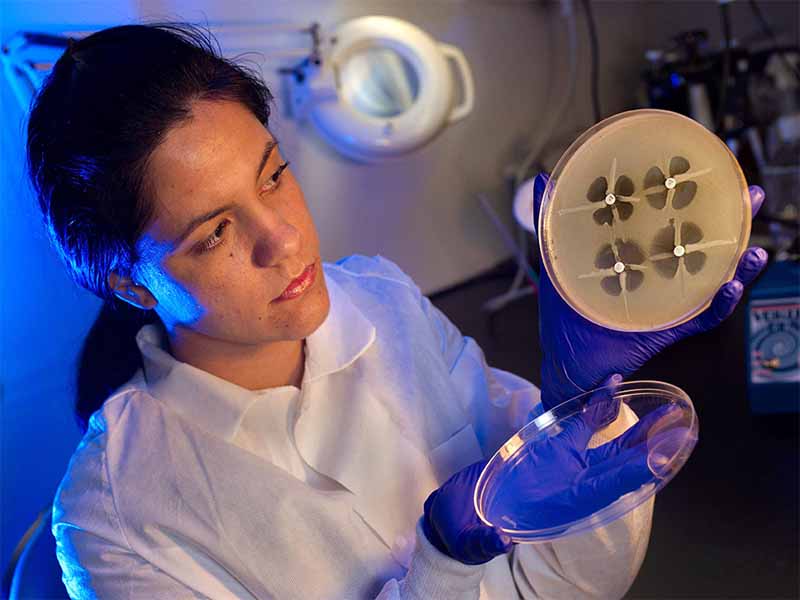CDC Strategy Effective Against Antibiotic-resistant Bacteria
April 10, 2018, 11:02 am News Staff – According to a recent CDC telebriefing, some 2 million Americans get infections from antibiotic-resistant pathogens each year, and 23,000 die from those infections.

To illustrate the depth of the problem, the CDC's Antibiotic Resistance Lab Network (ARLN), working with the health departments in all states and Puerto Rico, tested nearly 6,000 samples of highly resistant pathogens during the first nine months of 2017, finding that about one in four of these bacteria had a gene that helps it spread its resistance. Worse, ARLN also found 221 instances of "an especially rare resistance gene."
This information appears in a CDC Morbidity and Mortality Weekly Report (MMWR) and an accompanying Vital Signs report released April 3.
The agency's containment strategy for dealing with such pathogens includes rapidly identifying new or rare bacteria with unusual levels of antibiotic resistance so facilities can quickly isolate patients and begin aggressive infection control and screening actions to discover, reduce and stop transmission to others.
"The CDC's study found several dangerous pathogens, hiding in plain sight, that can cause infections that are difficult or impossible to treat," said CDC Principal Deputy Director Anne Schuchat, M.D., in a news release. "It's reassuring to see that state and local experts, using our containment strategy, identified and stopped these resistant bacteria before they had the opportunity to spread."
Story Highlights
Research Details
According to the MMWR, approaches to controlling emerging antibiotic resistance in health care settings have evolved over time. When resistance to broad-spectrum antimicrobials mediated by extended-spectrum beta-lactamases (ESBLs) arose in the 1980s, targeted interventions to slow their spread were not widely promoted. However, when Enterobacteriaceae with carbapenemases that conferred resistance to carbapenem antibiotics emerged, directed control efforts were recommended.
The current study sought to determine whether these distinct approaches could have resulted in differences in spread of these two pathogens.
To do so, the study analyzed infection data from the National Healthcare Safety Network from 2006-2015 to identify changes in the annual proportion of selected pathogens that were nonsusceptible to extended-spectrum cephalosporins (ESBL phenotype) or resistant to carbapenems (carbapenem-resistant Enterobacteriaceae [CRE]). Testing results for CRE and carbapenem-resistant Pseudomonas aeruginosa (CRPA) also were reported.
Researchers found the percentage of ESBL phenotype Enterobacteriaceae decreased by 2 percent per year; in comparison, the CRE percentage decreased by 15 percent per year.
Then, from January to September 2017, carbapenemase testing was performed for 4,442 CRE and 1,334 CRPA isolates; 32 percent and 1.9 percent, respectively, were found to be carbapenemase producers.
In followup, almost 1,500 screening tests were performed to identify asymptomatic carriers among health care contacts of index patients, of which 11 percent were positive.
Overall, the proportion of Enterobacteriaceae infections that were CRE remained lower and decreased more over time than the proportion that were ESBL phenotype.
"This difference might be explained by the more directed control efforts implemented to slow transmission of CRE than those applied for ESBL-producing strains," the CDC said. "Increased detection and aggressive early response to emerging antibiotic resistance threats have the potential to slow further spread."
Additionally, the study found
- further investigation in facilities with unusual resistance revealed that about one in 10 screening tests from asymptomatic patients identified a hard-to-treat pathogen that spreads easily, which means the organism could have easily spread in that health care facility; and
- for CRE alone, estimates showed that the CDC's containment strategy would prevent as many as 1,600 new infections in three years in a single state -- a 76-percent reduction.
CDC Containment Strategy
The CDC first outlined its containment strategy in 2017 to rapidly react to novel multidrug-resistant organisms. The approach encourages health care facilities and public health authorities to respond quickly to even single isolates of an emerging antibiotic-resistant pathogen.
The strategy contains five pillars:
- rapid detection of targeted pathogens and their resistance mechanisms,
- onsite infection control assessments by trained experts to identify gaps in infection prevention,
- screening of exposed contacts to identify asymptomatic colonization,
- coordination of response among facilities, and
- continuing these interventions until transmission is controlled; detection and control efforts can extend from the index facility to other facilities that share patients.
Importantly, the strategy requires a coordinated response among health care facilities, labs, health departments and the CDC.
So far, health departments that have implemented the containment strategy have successfully conducted infection control assessments and colonization screenings within 48 hours of finding unusual resistance and have reported no further transmission during several weeks of followup.
According to the CDC, this strategy complements other agency efforts that include improving antibiotic use and preventing new infections, as well as building on existing detection and response infrastructure.
The agency added that new data suggest the containment strategy can prevent thousands of difficult-to-treat or potentially untreatable infections, including high-priority threats such as infections caused by Candida auris.